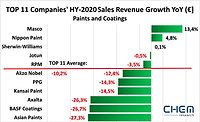China’s Coatings Market Shows Increased Output During First Half of 2017

GUANGZHOU, China - According to market research company CCM, China’s coatings market has witnessed another rise in output for the first half of 2017, while the profits for manufacturers went down due to rising raw material prices and pressure from environmental regulations.
During the first six months of this year, the combined output of 1,358 large-scale coating manufacturers in China increased by 10.50% year-over-year to 641,000 tonnes. The strong southern region of China supported the output growth, while other areas in west and north even saw declines in output.
In 2016, China produced 57% of coatings in the Asian-Pacific and 28.50% of the world total, proving that China had become a major production base of the international coating industry. In the first half of 2017, domestic coatings manufacturers ended up in the red, and losses surged year-over-year due to climbing prices of raw materials, environmental inspections and mergers in the coating industry.
During the latest round of environmental inspections in China, coatings manufacturers suffered huge pressures. Several small and middle-sized enterprises needed to shut down due to insufficient environmental protection.
According to market research company CCM, despite the rising output of China’s coatings industry, the profit for manufacturers actually fell in the first half of 2017. One of the main reasons for the shrinking profits can be found in the rising costs for raw materials like titanium dioxide (TiO2), as Chinese manufacturers are consuming about 60% of the domestic TiO2 supply yearly. Additionally, the price of emulsions, resins and solvents has increased by over 30% from 2016 to 2017.
Producers of coatings are very vulnerable to price hikes of raw materials because the costs of those can make up to 86% of the total operating costs. As a result, many coatings manufactures have increased their quoted prices to relieve some of the cost pressure.
According to statistics from the National Bureau of Statistics of the People's Republic of China, domestic large-scale coatings companies produced a total of 1.91 million tonnes of coatings in June 2017, up by 11.70% year-over-year, and the combined coating output from January to June increased by 10.50% year-over-year to 9.64 million tonnes.
Looking at the downstream industries of coatings in China, while the constructing industry in China is getting some setback by the government, the furniture and automobile industries are prosperous and driving the demand for coatings.
Emerging countries, like India and China, have booming construction and automotive markets, which are the main drivers for the coatings industry. Hence, the demand for coatings is very high. The Chinese coatings market has already climbed to the top spot in the world, according to size, but industry insiders still see huge potential for the future, as the consumption per-capita is still lower than other countries.
The industrial coatings market is growing steadily in China. The industry is marked by a number of mergers and acquisitions, and manufacturers are focusing on enhancing their product portfolio to stay ahead of fierce competition.
China’s subsidiary of PPG Industries, PPG Zhangjiagang, announced plans to expand its production lines of packaging coatings, industrial coatings and automotive paints. The current largest coating production base is PPG Paints, another subsidy located in Tianjin, China. PPG Tianjin was PPG's first factory in China and is mainly engaged in the production of high-performance automotive coatings and industrial paints. In 2016, sales and output from the plant reached $782 million and 110,000 tonnes. Zhangjiagang's new construction will actually be the fourth expansion to the production base. PPG has recently accelerated investment and capacity expansion in China. This can be attributed to pressure from AkzoNobel, which is developing rapidly, and the promising future of China's coatings market. In January 2016, the company opened a center for on-site electrocoat coatings in the Zhangjiagang facility. The center was mainly opened to meet the high demand in automotive manufacturing in China, which is in line with the growing environmental regulations in China.
Looking for a reprint of this article?
From high-res PDFs to custom plaques, order your copy today!







